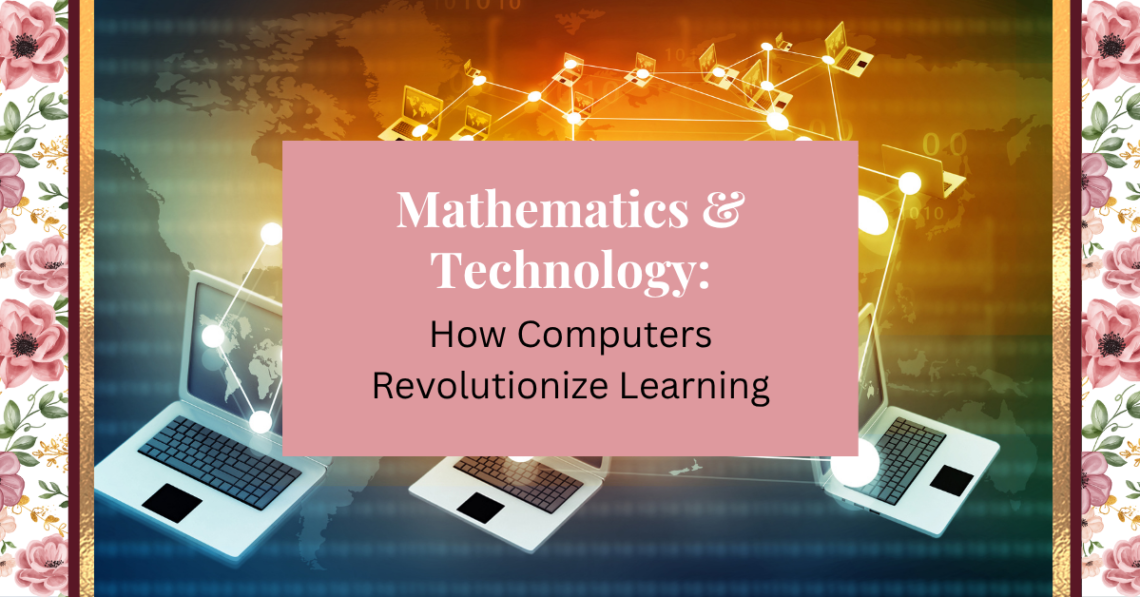Mathematics & technology have long had a symbiotic relationship. The advent of computers has fundamentally transformed how we teach, learn, and understand math. Gone are the days when students had to rely solely on textbooks, chalkboards, and calculators. Today, computers and technology provide powerful tools that not only make learning mathematics more engaging but also more effective. In this post, we’ll explore how computers are revolutionizing the way students learn math, enhance their understanding of complex concepts, and even apply mathematical skills in real-world contexts.
1. The Role of Computers in Mathematics Education
Mathematics, by nature, is abstract and requires a lot of problem-solving and critical thinking. Computers provide dynamic and interactive tools that allow students to engage directly with mathematical concepts, making learning more immersive and personalized. Let’s explore the ways technology enhances math education:
a) Visualizing Complex Concepts
One of the most powerful ways computers help in math education is by visualizing complex concepts. Many math topics, such as geometry, calculus, or linear algebra, involve abstract ideas that can be difficult for students to understand without visual aids.
For example:
- Graphing Functions: Programs like Desmos or GeoGebra allow students to graph mathematical functions, exploring how changes in variables affect the graph’s shape. This makes abstract concepts like limits, derivatives, or transformations more tangible.
- 3D Geometry: Visualizing three-dimensional shapes, volumes, and angles is much easier with computer graphics. Tools like GeoGebra 3D allow students to manipulate shapes and explore their properties interactively.
This hands-on approach helps bridge the gap between theoretical understanding and practical visualization, allowing students to see mathematical principles in action.
b) Immediate Feedback and Assessment
Computers also offer immediate feedback, which is crucial for effective learning. Students can practice problems on platforms like Khan Academy, Wolfram Alpha, or Brilliant.org, and receive instant feedback on whether their answers are correct. This provides them with the opportunity to correct mistakes in real time, reinforcing learning and boosting confidence.
Unlike traditional worksheets where teachers must grade problems manually, technology enables students to work at their own pace. They can attempt problems multiple times without the fear of judgment, gaining a deeper understanding through trial and error. This also allows teachers to monitor progress and tailor lessons to individual needs.
c) Adaptive Learning Technologies
Some computer programs use adaptive learning algorithms, which adjust the difficulty of problems based on the student’s performance. As students improve, the system increases the difficulty, offering more challenging problems to keep them engaged. Conversely, if students are struggling, the system can provide more basic problems or additional explanations to reinforce foundational concepts.
Platforms like ALEKS and DreamBox use adaptive learning to customize math instruction, ensuring that each student receives the right level of challenge and support.
2. Computational Tools for Solving Mathematical Problems
Computers can process complex calculations much faster than humans. This capability has revolutionized how mathematicians, scientists, and engineers solve problems, and it has also had a significant impact on how students learn mathematics.
a) Mathematical Software
Programs like MATLAB, Mathematica, and Maple are widely used in higher education and professional settings to solve advanced mathematical problems. These tools can perform symbolic computations, numerical analysis, and even visualize solutions, which would be incredibly time-consuming to do by hand.
For example, in calculus, students can use software to differentiate and integrate complex functions. This allows them to focus on understanding the concepts behind the equations rather than spending excessive time on tedious calculations.
Similarly, in linear algebra, these tools can solve large systems of equations or find eigenvalues and eigenvectors, helping students understand the theoretical underpinnings without being overwhelmed by manual calculations.
b) Programming for Mathematical Problem Solving
The rise of programming languages like Python, R, and Julia has further changed the landscape of math education. By learning how to code, students can solve mathematical problems computationally and even create their own mathematical models. This provides a hands-on approach to mathematics that is both practical and innovative.
For instance, Python has libraries such as NumPy and SciPy, which are designed for numerical computations and scientific computing. Students learning calculus can use these tools to implement algorithms, simulate mathematical models, and visualize results. Programming also introduces students to concepts like loops, conditional statements, and functions, which are essential in both mathematics and computer science.
c) Simulations and Models
Simulations powered by computers allow students to experiment with mathematical models in ways that were not possible before. For example, students studying probability theory can run simulations of random events, such as flipping coins or rolling dice, to observe how probability behaves in practice.
Monte Carlo simulations are used in many fields, from finance to physics, and these can be run on a computer. By running thousands or millions of simulations, students can gain an intuitive understanding of probability and statistics.
In differential equations, students can simulate dynamic systems, like population growth or the spread of diseases, and observe how variables interact over time. These hands-on simulations deepen understanding by connecting mathematical theory to real-world phenomena.
3. Enhancing Collaboration and Engagement
One of the benefits of using computers in math education is the ability to collaborate and share knowledge with others. Technology has made it easier for students to work together, whether in person or virtually, and has expanded their opportunities for collaborative learning.
a) Online Math Communities
Online platforms like Stack Exchange, Math Stack Exchange, and Reddit’s Math forums allow students to ask questions, share solutions, and collaborate with peers and experts from around the world. This opens up opportunities for learning beyond the classroom and allows students to see multiple approaches to solving problems.
b) Collaborative Projects and Tools
Cloud-based tools like Google Docs and Microsoft OneNote allow students to work together on mathematical problems and projects. They can share documents, solve problems in real-time, and brainstorm solutions collaboratively, regardless of their physical location.
In addition, tools like Padlet and Trello can help students organize their work and keep track of progress on collaborative math projects, whether it’s a research project on statistics or a group task involving geometric constructions.
4. Technology and Math Education Beyond the Classroom
Beyond traditional classroom learning, technology has expanded the ways in which students can engage with math. Online courses, tutorials, and educational games provide students with the ability to learn at their own pace, in environments that feel less like traditional school settings.
a) Online Courses and Learning Platforms
Platforms like Coursera, edX, and Udemy offer courses in advanced mathematics topics, such as calculus, linear algebra, cryptography, and number theory. These platforms often feature video lectures, problem sets, quizzes, and interactive tools that allow students to engage with content on their own time. Many universities also offer free online courses, making high-quality math education accessible to anyone with an internet connection.
b) Gamification of Math Learning
Mathematics can sometimes be intimidating, but gamification has proven to be an effective way to make math more engaging. Websites and apps like Prodigy Math and Mathletics turn math into a fun game, where students solve problems to earn points, level up, and unlock rewards.
Gamification motivates students by turning learning into an interactive, enjoyable experience. It encourages healthy competition and allows students to track their progress, making math feel less like a chore and more like a challenge.
5. The Future of Math Education with Technology
As technology continues to evolve, the role of computers in math education will only grow. Artificial intelligence (AI) and machine learning are already being integrated into math platforms to offer even more personalized learning experiences. For example, AI-powered tutoring systems like Socratic can provide tailored explanations and hints based on a student’s progress.
With advances in augmented reality (AR) and virtual reality (VR), students may soon be able to experience math in entirely new ways, like walking through a 3D graph of a function or interacting with geometric shapes in a virtual environment.
Conclusion
Computers have revolutionized the way students learn mathematics, offering tools that enhance understanding, provide instant feedback, and allow for more engaging and interactive learning experiences. From visualizing complex concepts to solving intricate equations, technology empowers students to explore the world of mathematics in new and exciting ways.
As technology continues to advance, the future of math education is more dynamic and inclusive than ever before. Students can now learn at their own pace, collaborate with peers globally, and apply their mathematical skills to real-world problems. The fusion of mathematics and technology is an exciting journey that opens up countless possibilities for both students and educators alike.
How has technology impacted your own learning of mathematics? Share your thoughts in the comments below, and let’s keep the conversation going on how technology is shaping the future of math education!





